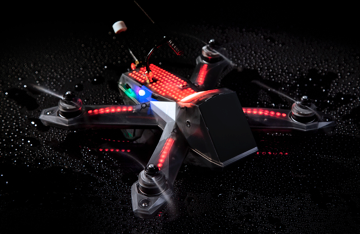Drone Engines Increase Their Buzz
The next-gen racer in the Drone Racing League revs up
Story Highlights
The sound of engines in racing has always been a foundational part of any motorsport’s emotional engagement, but, at a time when NASCAR is looking to throttle back the volume of its engines (and potentially turning off some of its fans in the process), drone racing is ramping up its own joyous noise level.
According to Ryan Gury, director of product for the Drone Racing League (DRL), the sound of racing drones may initially have been an afterthought, with speed and agility the primary goals in their design, but the sound of the latest models is turning out to be a “happy accident.”
The newest model, the Racer3, introduced this year, is insanely fast. The dinner-plate–size drone can reach 80 mph from a standing start in less than one second, developing 16 lb. of thrust (an 8:1 power-to-weight ratio) from an increased-voltage powertrain, pushing its 900-gram carbon-fiber fuselage up to 85 mph through a 1.5-mile obstacle course in less than a minute.
But the combination of the R3’s larger propellers — 6 in. in diameter, about 20% larger than the previous generation’s props — with the more powerful battery engines — the new ones bulk up with 1,800 mAh (milliampere hours: 1 mAh is the amount of capacity needed to let one milliampere of electrical current flow for one hour) — has exponentially enhanced their sound.
“We didn’t realize the thing was so damn loud until we raced it with real pilots,” says Gury. “It’s considerably louder then your typical drone. The [propeller] blades are larger, and they’re turning at a higher [29,000] rpm. A big-block NASCAR engine can sound scary, but, when these [drones] hit their top speed, they sound absolutely ferocious.”
The louder drones sound scarier still when raced in the typical empty stadiums and other cavernous venues: the naturally reverberant ambience amplifies the intense buzz, taking it up to banshee level.
Gury says drone aficionados, like their internal-combustion counterparts, have tuned their ears to the sound of the engines. “I can tell the number and size of the blades just by what they sound like,” he explains. “Now the pitch and the volume of the sound have increased again, and you can really notice it. It’s scarier then ever.”
You can hear that for yourself: the new R3 drones will be flying throughout the DRL 2017 season, the Allianz World Championship, which airs for the first time on June 20 (8 p.m. ET) on ESPN.

